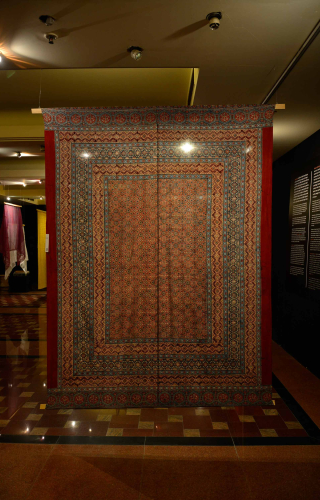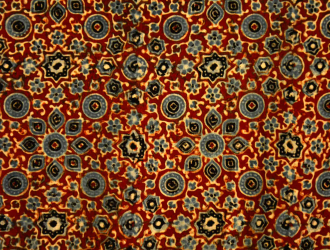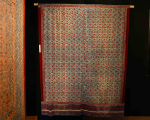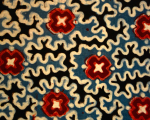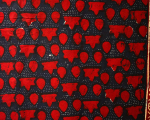This image gallery presents examples of Printed textiles.
Printed textiles, the embellishment of cloth with patterns printed with carved wooden blocks is a craft that has been done in India for centuries. Archaeological evidence suggests that block printed textiles existed as far back as 3000 BCE, during the period of the Indus Valley Civilisation. In more recent times, from around the seventeenth century, Indian printed textiles were renowned for their designs and colours, as well as their colour-fastness, and were traded across the world.
Printing involves the placing or withholding of colour or pattern on cloth, thus producing two kinds of spaces: the embellished space and the background space, or, respectively, positive space and negative space. The distinction between the spaces defines where the cloth receives or resists the various interventions, and this is fundamental of hand-printed techniques.
Three kinds of blocks are used in printing: Rekh for the outline of the motif, Daat or Datta for the filling of the motif, and Gadh for the background of the design. The number of Daat or Datta blocks used depends on the number of colours that need to be filled.
In traditional dyeing and printing, a 'mordant' (or absorbing agent) is applied to receive colour, and a 'resist' (or blocking agent) to repel it. Sometimes, mordant and resist processes are repeated several times to produce a complex, layered pattern of many colours, for example in Ajrakh, or in double or triple Dabu, the mud-resist technique. In other traditions such as Bagh, a typical feature is the printing of the Gadh or background, so that the actual motif emerges in the negative, where the colour has not been applied.
Critical to fine printing is the quality of wood and the quality of the carving. Blocks are sometimes made with an air circulatory system for fine printing, or covered with felt to achieve dense and precisely defined patterns. While blocks are also made of metal and terracotta, woodblocks have been used most widely.
The discovery of chemical dyes has led to two other printing techniques. In Direct Printing, a chemical dye is applied directly to the cloth as there is no need for prior treatment of cloth with mordant. In Discharge Printing, the fabric is first dyed and then a chemical applied with a wooden block to remove the dye, producing the pattern in negative, in the original colour of the cloth. This can be printed again with another colour if desired.
Traditionally, the printed cloths of Western India have been laden with markers of identity, defining community, status, gender etc. But with increasing urbanisation and widening markets, the significance of these markers has declined.
